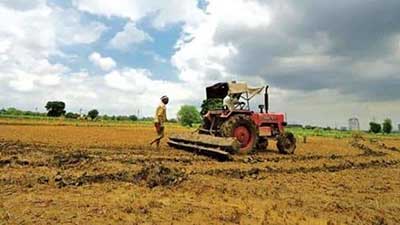Relevance: GS-3: Major crops and cropping patterns in the country, agricultural produce, Minimum Support Prices (MSP).
Key Phrases: Normal monsoon, FMCG, IMD, Monsoon, Heat Wave, cash strapped, the rural GDP, integrated policy, agri-commodity, Rural demand.
Context:
- Rural demand has been weak over the last 12 months or more inspite of copious rain coupled with good harvests and higher than usual agri-commodity prices.
Background:
- It is not often that India gets three continuous years of normal monsoon like in the period 2019-21.
- The last time this happened was way back in 1892-94, if one looks at the monsoon data that is available since 1871.
- In fact, rural India or Bharat, should be driving the nation’s consumption story and, thereby, fuelling economic growth. But the ground reality is different. Rural demand has been weak over the last 12 months or more.
- Tractor sales have slowed and so has the sale of two-wheelers. Fast Moving Consumer Goods (FMCG) companies have been hit particularly hard. It is forced to give higher credit to its retailers as collection efficiency has declined from 12 days to 20.
- Almost all FMCG companies suffered margin erosion as poor rural off-take impaired their ability to pass cost increase (due to supply chain disruption and Russia-Ukraine war).
Factors Slowing down the Demand:
- Second wave of Covid :
- Just when urban centers recovered from the first wave and everyone was hoping for a period of strong demand both from rural and urban India, the second Covid wave struck in April 2021.
- This time smaller towns and villages bore the brunt of the pandemic.
- Lack of adequate health infrastructure complicated matters, causing large-scale deaths.
- Poor health insurance penetration in rural India meant that out-of-pocket medical expenses shot up. This caused rural demand to slump and has not recovered since.
- Monsoon, Heat Wave
- While the 2021 South-West monsoon has been classified as normal, it had an extended run and this impacted harvest in certain parts of the country.
- Many farmers suffered from lower output and, consequently, lower realisation. Then was followed by the heat wave which also hurt the output.
- The current heat wave in many parts of country is also impacting production of horticulture crops such as tomato and onion.
- Cash strapped MSMEs
- MSMEs that dominate rural space are cash strapped and yet to recover from the effect of the pandemic. They too need to fire on all cylinders for a vibrant rural economy.
- Decline in Wages
- Experts have also flagged that rural wages have been on the decline recently. It looks like funds allocated for MGNREGS are getting exhausted and this is causing wages and also the quantum of work allocated to drop.
- Reduce in rural infrastructure spending
- There have also been reports of rural infrastructure spending, such as on roads, slowing down.
- While this will mean that more labour will be available for farming activity at a lower cost, lower income would mean lower spending.
Do you know?
- The government announced its ambitious dream of doubling farmers’ income by 2022-23 in 2015-16. Incomes would have to grow annually by 10.4% to double in seven years.
- More than 45% of the workforce is engaged in a sector which contributes less than 17% to the country’s gross domestic product.
Ways to revive Rural Economy:
- Sustainable Agriculture:
- Working with farmers towards a new paradigm by shifting from intensive chemical-based agriculture to adopting sustainable eco-friendly agriculture practices.
- Explore Exports aggressively
- Agricultural value chains and production systems in countries like Italy, France, and Germany, which are major agri-goods producers, have been severely impacted and are likely to take a while to recover.
- This could therefore, be an opportunity for India to tap the world food market as a supplier.
- Create an Enabling Policy Environment:
- The final and most important step in reviving the rural economy is an integrated policy package which looks at the entire rural situation holistically.
- We need to look at non-farm sectors like handlooms, handicrafts, and rural SMEs to unlock the full potential of employment and income generation.
Conclusion:
- The government should keep a close watch on the progress of the monsoon and other pain points of the rural economy.
- After all, it accounts for 46 per cent of national income and 30 per cent of the nation’s GDP.
- Proactive measures will certainly help weather the crisis in case monsoon plays truant. If not, such measures will ensure faster bounce back in rural demand.
Sources: The Hindu BL
Mains Question:
Q. Inspite of copious rain coupled with good harvests and higher than usual agri-commodity pricesrural demand has been weak over the last 12 months or more. Critically examine.(250 words).








